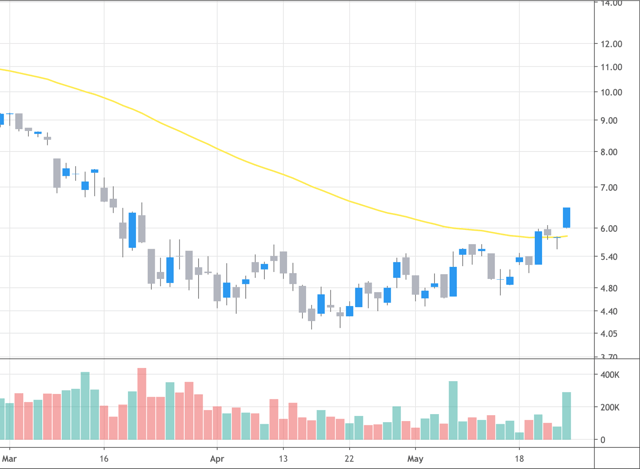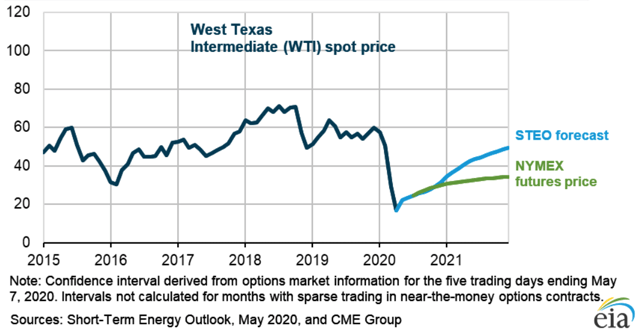North American Construction Group: Growth, Value, And Bullish Insiders
by Mitchell RosenthalSummary
- ROE is 28% vs. industry median of -1.6%. Revenues up 241% since Q4 2016. EBITDA has a 3-year CAGR of 45% vs. industry median of 7%.
- P/S is the lowest it's been since 2016, currently standing at 0.3. P/E has fallen 95% since September 2017. Most valuation multiples are at least 30% below industry average.
- Management believes shares are underpriced and has planned buybacks. CEO owns > 2 million shares. Jim Simons of RenTech owns 2.6% of shares. EIA and futures are expecting higher oil prices.
Elevator Pitch
North American Construction Group Ltd.'s (NOA) stock is selling close to bargain prices, yet the company's long-term fundamentals are impressive and it has some of the best margins, revenue, and EBITDA growth in its industry. Management said on May 6th that it plans to buy back shares because current prices didn't reflect the company's intrinsic value. Rising oil prices could be another tailwind for NOA, and the futures market, as well as the Energy Information Administration, expect rising oil prices into the end of 2021. Investors have shrugged off guidance for a rough Q2 2020, and price action is becoming increasingly bullish.
About
North American Construction Group Ltd. assists resource development companies in western Canada. They provide construction services, operational support, and heavy equipment maintenance to help companies exploit the Canadian oil sands. NOA also has an ownership interest in the Nuna Group of Companies, which extracts base metals, precious metals, and diamonds in Ontario and British Columbia.
Fundamentals & Valuation
During the energy sector's massive 50% drop this year, NOA shares fell from $11 to $4.75 before bottoming in mid-April. Since then, the stock began a new rally, yet valuations still look very attractive on a historical and relative basis. Long-term fundamentals are impressive, and the company has some of the best margins, revenue, and EBITDA growth in its industry.
Revenues over the last twelve months have risen 241% since Q4 2016 and are the highest they've been since Q2 2013. The company's ROE of 28% is higher than that of 93% of peers in the oil and gas industry, according to GuruFocus, and well above the industry median of -1.6%. That ROE has improved significantly since Q3 2015, when it stood at -4.5%, according to data from StockRow. The company's revenue and EBITDA have both seen a 3-year CAGR of 45%, compared to the industry median values of 6.9% and 8.3%, respectively.
Meanwhile, the stock's P/S ratio is in bargain territory. It stands at 0.3, the lowest it's been since 2016. Its P/E has fallen substantially since September 2017, falling from 100 to a mere 4.56. PEG currently stands at 0.19. Most valuation multiples are at a significant discount to the median values of its peers.
CEO Martin Ferron still owns more than 2 million shares, and Q1 2020 was a great quarter. Revenues rose 7% YoY. Adjusted EBITDA and EPS rose 15% and 37% YoY, respectively. And even though management forecasted a 35% YoY drop in Q2 2020 revenues, investors have shrugged off the news since that May 6th report. Shares have continued to rally, recently breaking above the 50-day moving average and surging 11% on May 27, with strong volume. This compares to an 8% move in the sector as a whole that day (see below). Management believes Q2 will be the low point in 2020 and expects steady normalization for the remainder of the year.

Management is confident in their liquidity positioning. As their 6-K notes:
"Our reduced capital spending projection now calls for full year sustaining capital in 2020 of $65.0 million to $80.0 million, of which approximately $40.0 million was completed in the first quarter and was consistent with original budgeted capital plan. For the impacted time period of Q2 to Q4, this represents a 50% reduction in capital spending from our previously stated planning... We expect liquidity to remain above $100.0 million during the remainder of 2020. In the immediate term, projected free cash flow for the second quarter of 2020 in the range of $10.0 million and $15.0 million will maintain our liquidity position over the next three months."
CEO Martin Ferron still owns more than 2 million shares. Management believes shares are undervalued and is planning on buying back shares:
"On March 9, 2020, we announced our intention to commence a normal course issuer bid ("NCIB") to purchase for cancellation up to 2,300,000 common shares in the capital. This represented approximately 8.3% of the issued and outstanding common shares as of March 3, 2020... We believe that the current market price of our common shares does not fully reflect their underlying value. In our view, prudent repurchases of common shares at these low market prices is an effective use of our cash resources and is in the best interests of us and shareholders."
The futures market, as well as the Energy Information Administration, is bullish on oil prices into the end of 2021. This is another potential tailwind for NOA (see below).

Finally, it's always a good sign when "smart money" has some interest in the stock. Jim Simons, famed investor and founder of Renaissance Technologies, owned 2.59% of outstanding shares as of 3/31/2020.
Bottom Line
After the energy sector's 50% decline this year, the sector presents opportunities for value investors. The idea is to find stocks that have fallen severely but do not deserve to sell for bargain prices. This appears to be the case for NOA; the stock fell slightly more than the sector, yet its fundamentals and growth put it ahead of most of its peers. The fact that management sees shares as undervalued and is planning buybacks reduces the likelihood of the stock being a value trap. Now that price action has stabilized and turned bullish, and that EIA and futures participants expect rising oil prices, investors have a higher reward/risk setup than they would normally expect to see in this sector.
Disclosure: I/we have no positions in any stocks mentioned, but may initiate a long position in NOA over the next 72 hours. I wrote this article myself, and it expresses my own opinions. I am not receiving compensation for it (other than from Seeking Alpha). I have no business relationship with any company whose stock is mentioned in this article.